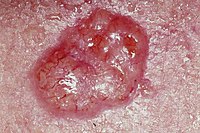
Photo from wikipedia
Vulvar squamous cell carcinoma (SCC) is the most common vulvar malignancy, and about 60% of cases arise after menopause. Vulvar SCC is usually associated with a pre-existing vulvar intraepithelial neoplasia… Click to show full abstract
Vulvar squamous cell carcinoma (SCC) is the most common vulvar malignancy, and about 60% of cases arise after menopause. Vulvar SCC is usually associated with a pre-existing vulvar intraepithelial neoplasia (VIN), in particular differentiated VIN (DVIN), which is often associated with vulvar lichen sclerosus (VLS). We propose some dermoscopic features of DVIN and vulvar SCC and a dermoscopic progression model. Figure 1a shows a DVIN in the context of VLS, with a central erosion. Dermoscopy of DVIN revealed a pink to red, structureless background (Fig. 1b), with red areas (upper part) due to superficial erosions and vascular structures (lower part) consisting of curvy, short serpentine and some dotted vessels. Figure 2a shows a microinvasive vulvar SCC appearing as a whitish hyperkeratotic plaque with a rough surface and erosions. Dermoscopy of this lesion (Fig. 2b) showed a whitish background with polymorphous vessels (curvy, dotted, linear–irregular, and also some hairpin-shaped vessels) Fig. 2c is of an invasive vulvar SCC, presenting as a whitish plaque with an ulcerated area; dermoscopy (Fig. 2d) showed a white background due to hyperkeratosis surrounding the ulcerated area, and a number of highly polymorphous vessels, with curvy and linear–irregular vessels detectable centrally (Fig. 1d) and hairpin vessels at the periphery (Fig. 1e). DVIN is characterized by a differentiated histopathological morphology, with premature keratinizing differentiation leading to squamous whorls and keratin pearls, often arising in the context of VLS, as in our case. DVIN, microinvasive SCC and invasive SCC are very closely related entities. We tried to define a progression model linking them, similar to the progression model from actinic keratosis (AK) to intraepidermal carcinoma and invasive SCC proposed by Zalaudek et al. According to that model, most AKs are characterized by a red pseudo-network (‘strawberry’) pattern, while during the progression to intraepidermal carcinoma, yellow opaque structures and dotted vessels become evident. White structureless areas and dotted or hairpin vessels characterize the transition to SCC, and in minimally invasive SCC, a central mass of keratin and hairpin vessels are seen. Finally, linear–irregular vessels, keratinization and ulceration characterize invasive SCC. In our case series, the red colour was predominant in DVIN, then the white colour became more evident during the progression to microinvasive SCC and invasive SCC (except in ulcerated areas), and these findings appear to be in line with the aforementioned model. Moreover, in DVIN, mainly curvy and short-serpentine vessels were seen, as previously described, while in microinvasive vulvar SCC, curvy, dotted, linear–irregular and some hairpin vessels were observed. In invasive SCC, the vessels appeared highly polymorphous (hairpin vessels peripherally, curvy and linear–irregular vessels centrally) together with ulceration. The observation of different colours and vascular patterns (leading to hairpin and linear–irregular vessels in the later stages) may aid the differential diagnosis
Journal Title: Clinical and Experimental Dermatology
Year Published: 2018
Link to full text (if available)
Share on Social Media: Sign Up to like & get
recommendations!